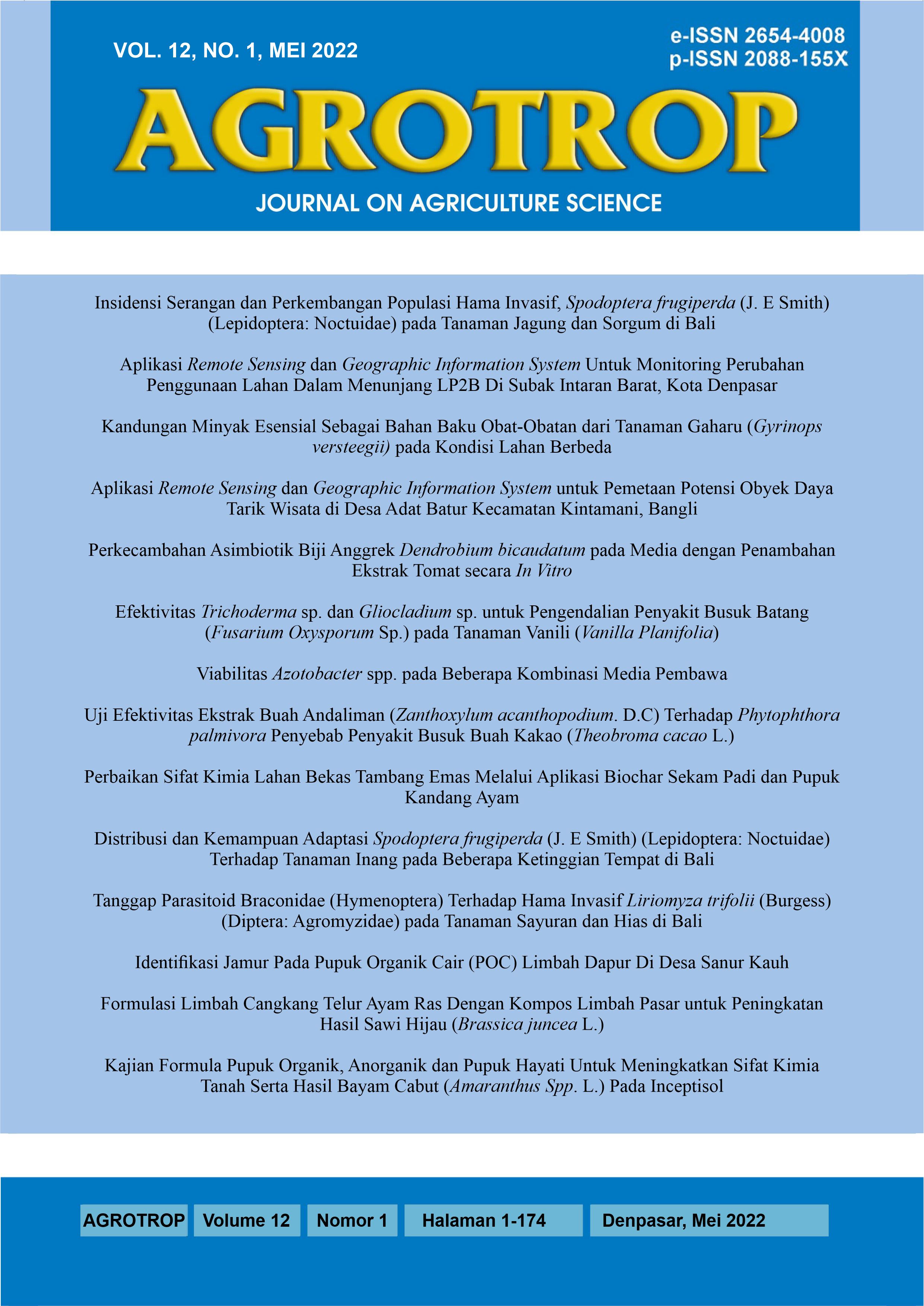Insidensi Serangan dan Perkembangan Populasi Hama Invasif, Spodoptera frugiperda (J. E Smith) (Lepidoptera: Noctuidae) pada Tanaman Jagung dan Sorgum di Bali
Abstract
Incidence of Attacks and Population Development of Invasive Pests, Spodoptera frugiperda (J.E Smith) (Lepidoptera: Noctuidae) on Corn and Sorghum Crops in Bali. Spodoptera frugiperda is known as an invasive pest which now become important pest on corn crops in Indonesia and Bali in particular, but in this study the Spodoptera frugiperda was also found to attack sorghum. This study used purposive survey method and on land that had been fixed. Plant sampling was carried out in all regencies of Bali Province by means of diagonal sampling. The size of unit sample was 2 x 2m and the number of plants observed was 20 plants. The results of this study showed that the incidence of S. frugiperda attack has been observed on plant beds in all districts/cities in Bali which is indicated by symptoms of attack and abundance of S. frugiperda population on corn and sorghum in the field. The highest abundance of S. frugiperda larvae population was in sweet corn in Klungkung Regency as much as 38.67 heads, and the lowest was in sorghum numbu in Tabanan Regency as many as 27.00 individuals per observation plot. Population development of egg groups was found in plants aged 1 (MST) while larvae of S. frugiperda showed the same pattern in sweet corn, sticky rice and pipil plants and the peak of larval population occurred in plants aged 4 WATS respectively. While the peak population of larvae in sorghum plants occurred at 5 WAP and imago populations in sweet corn were found in sweet corn plants at 2 WAP and glutinous corn at 4 WAP. The highest percentage of S. frugiperda attack was on sweet corn with an average attack of 43% per observation plot and the lowest on sorghum numbu with an average of 25% per observation plot.
Downloads
References
Arifin M. (2012). Bioinsektisida SNPV untuk mengendalikan ulat grayak mendukung swasembada kedelai. Pengembangan Inovasi Pertanian 5(1):19-31. Armico, Bandung. Hal. 40-41.
CABI (Food and Agriculture Organization). (2019). Community-Based Fall Armyworm (Spodoptera frugiperda) Monitoring, Early Warning and Management. Training of Trainers Manual, First Edition. 112 pp.
Deshmukh Sharanabasappa S., B. M. Prasanna, C. M. Kalleshwaraswamy, Jagdish Jaba, and Bhagirath Choudhary. 2021. Fall Army Worm Spodoptera frugiperda (J. E. Smith). Indian Journal of Entomology 82(3):349-372. https://www.doi.10.1007/978-981-15-8075-8 _
Elisa, N. (2013). Ekologi Serangga. Universitas Gajah Mada. Yogyakarta.
Ganiger PC, Yeshwanth HM, Muralimohan K, Vinay N,Kumar ARV, Chandrashekara K. (2018). Occurrence of the new invasive pest, fall armyworm, Spodoptera frugiperda (J. E. Smith) (Lepidoptera, Noctuidae), in the maize fields of Karnataka, India. Current Science;115(4):621–23.https://www.doi.10.18520/CS/V115/I4/ 621-623.
Hruska, A. J. (2019). Fall armyworm (Spodoptera frugiperda) management by smallholders. CAB Rev 14 (043): 1-11. https://www.doi.10.1079/ PAVSNNR201914043
Kartosuwondo, U. (1993). Dasar-dasar Pemanfaatan Brassicaceae Liar Untuk Konversi Parasitoid Diadegma semiclausum Hellen (Hymenoptera: I chneumonidae) dalam Mendukung Pengendalian Hama Terpadu Plutella xylostella Linn (Lepidoptera: Ponomeutidae). Disertasi Program Pasca Sarjana (tidak dipublikasikan). IPB. Bogor.
Kementrian Pertanian. (2019). Pengenalan Fall Armyworm (Spodoptera Frugiperda J.E. Smith) Hama Baru pada Tanaman Jagung di Indonesia. Kementrian Pertanian Republik Indonesia. Ebook. 50 hal.
Maramis, R. (2005). Kontribusi dari Berbagai Spesies Parasitoid Generalis yang Berasal dari Serangga Inang Erionota thrax (L.) (Lepidoptera: Hesperiidae) pada Habitatnya. Departemen Biologi ITB. Bandung.
Pitre, H, N., Mulroonry, J., Hoog, D.D.B. (1983). Fall armyworm (Lepidoptera: Noctuidae) oviposition: crop preferences and egg distribution on plant. J Econ Entomol 76: 436-466. https://www.doi.org/10.1093/jee/76.3.463
Price, P. W. (1991). The plant vigor hypothesis and herbivore attack. Oikos, 62: 244 – 251.
Putra, IG.F.M. (2020). Karakteristik Serangan Dan Pola Persebaran Hama Invasif Spodoptera frugiperda J. E SMITH (Lepidoptera: Noctuidae) Pada Pertanaman Jagung Di Bali. Tesis. Fakultas Pertanian, Universitas Udayana, Bali.64:43-50.
Putrasamedja, S., Setiawati, W., Lukman, L., Hasym, A. (2012). Penampilan beberapa Klon Bawang Merah dan Hubungannya dengan Intesitas Serangan Organisme Pengganggu Tumbuhan. 22(4):349-359. http://www.dx.doi.org/10.21082/ jhort.v22n4.2012.p349-359
Sharanabasappa., Kalleshwaraswamy, C.M., Asokan, R., Mahadeva-Swamy, H.M, Maruthi, M.S., Pavithra, H.B., Hedge, K., Navi, S., Prabhu, S.T., Goergen, G. (2018). First report of the fall armyworm Spodoptera frugiperda (JE Smith) (Lepidoptera: Noctuidae) an alien invasive pest on maize in India. Pest Manag Hortic Ecosyst 24 (1): 23-29.
Sirappa, M. P. (2003). Prospek Pengembangan Sorgum di Indonesia Sebagai Komoditas Alternatif untuk Pangan, Pakan dan Industri. Jurnal Litbang Pertanian 22 (4): 133-140.
Slansky, F. (1993). Nutritional Ecology: The Fundamental Quest for Nutrient. Champman and Hall, New York.
Suherman., D. P, Yusnia., Hermanu. (2021). Perilaku Imago dan Penetasan Telur Spodoptera frugiperda (J.E. Smith) (Lepidoptera: Noctuidae). http://www. repository.ipb.ac.id/handle/123456789/105405
Supartha, I W., I W, Susila. A.A.A.A. S, Sunari., I G, Febri Mahaputra., IK. W, Yudha., P. A, Wiradana. (2021a). Damage characteristics and distribution patterns of invasive pest, Spodoptera frugiperda (J.E Smith) (Lepidoptera: Noctuidae) on maize crop in Bali, Indonesia. Biodiversitas, 22 (6): 3378-3387. https://www.doi.10.13057/biodiv/d220645
Supartha,I.W., Sunari, A.A.A.A.S., Krisna, I.G.P.B., Yudha, I.K.W.,Mahaputra, I.G.F.,Wiradana,P.A. (2021b). Invasion, Population Development, and Attack Intensity of The Fall Armyworm (Spodoptera frugiperda) J.E Smith (Lepidoptera: Noctuidae) On Two Varieties Corn In Serongga Village, Gianyar Regency, Bali –Indonesia. Jurnal Technology Reports of Kansai University, 63(0):6949-6950.
Trisyono, Y, A., Suputa., Aryuwandari, V,E,B., Hartaman, M., Jumari. (2019). Occurrence of heavy infestation by the fall armyworm Spodoptera frugiperda, a new alien invasive pest, in corn in Lampung Indonesia. Jurnal Perlindungan Tanaman Indonesia 23 (1): 156-160. https://doi.org/10.4001/003.026.0286.
Vaughan, C. E., Moore, R. P. (1970). Proc. Assoc. off. Seed. Tetrazolium Evaluation of The Nature. 104-117.
Masadi D., Supartha, I W., Sunari, A.A.A.A.S. (2017). Invasi dan Tingkat Serangan Ulat Bawang (Spodoptera exigua Hubner) pada Dua Kultivar Tanaman Bawang Merah di Desa Songan, Kecamatan Kintamani, Kabupaten Bangli. E-Jurnal Agroekoteknologi Tropika. 6 (4): 360-369. https://ojs.unud.ac.id/index.php/JAT











